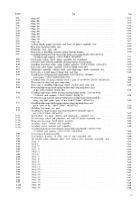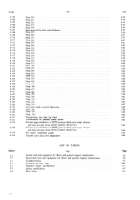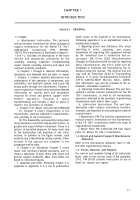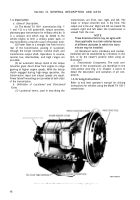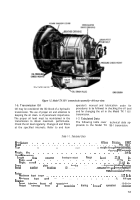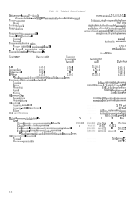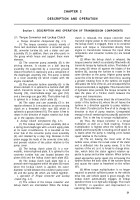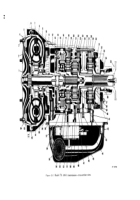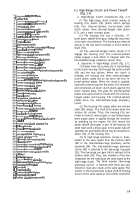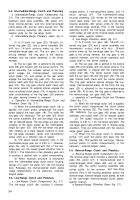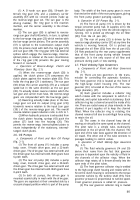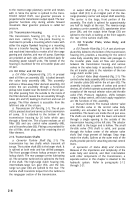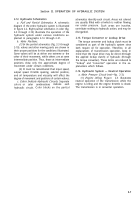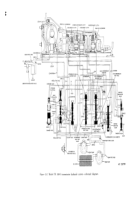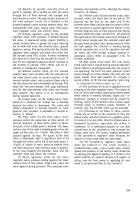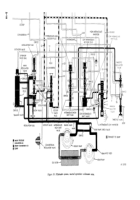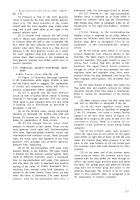TM-9-2520-254-34 - Page 14 of 126
(1) A 31-tooth sun gear (38), 59-tooth (in-
ternal) ring gear (29), and a planetary carrier
assembly (37) with six
1
4-tooth pinions make up
the reverse-range gear set. The sun gear is the
driving member,
the ring gear is the reaction
member, and the carrier assembly is the driven
member.
(2) The sun gear (38) is splined to reverse-
range sun gear shaft (40) which, in turn, is splined
to the low-range ring gear (23) which meshes with
the low-range carrier pinions. The carrier assembly
(37) is splined to the transmission output shaft
(33). Its pinions mesh with both the ring gear (29)
and sun gear (38). The ring gear (29) has external
splines which engage the reverse-range, internal-
splined plates. A retainer at the outer circumference
of the ring gear (29) prevents the gear moving
forward or rearward.
c. Operation of Reverse-Range
Clutch and
Planetary Gears
(fig. 2.1).
(1) When the reverse-range clutch (28) is
applied, the clutch piston (27) compresses the
clutch plates against the reaction plate (30). This
holds the ring gear (29 ) stationary. The sun gear
(38) drives the carrier assembly (37) at a reduced
speed but in the same direction as the sun gear
(38). To actually obtain reverse rotation which the
sun gear and carrier must have, the reverse-range
gears are compounded with the low-range gears.
(2) Reversing actually takes place in the low-
range gear set and its output (ring gear (23))
transmits reverse rotation to the input (sun gear
(38) ) of the reverse-range gear set. The overall
reverse-rotation speed reduction ratio is 4.35 to 1.
(3) When hydraulic pressure is exhausted from
the clutch piston housing, springs (43) push the
piston (27) back into the housing (26). This
permits the reverse-range, internal-splined plates to
rotate independently of the stationary, external-
tanged clutch plates.
2-6. Oil Pumps
a. Components of Front and Rear Oil Pumps
(fig. 2-1).
(1) The front oil pump (11) includes a pump
body, cover. 19-tooth drive gear, and a 22-tooth
driven gear. The drive gear has external teeth and
the driven gear has internal teeth. Both gears have
6-pitch teeth.
(2) The rear oil pump (32) includes a pump
body, cover, 26-tooth drive gear, and a 30-tooth
driven gear. The drive gear has external teeth and
the driven gear has internal teeth. Both gears have
8-pitch teeth.
(3) In both oil pumps, the driven gear is
mounted eccentrically in mesh with the drive gear.
The gears are separated at their unmeshed side by a
crescent-shaped partition which is part of the pump
body. The width of the front pump gears is more
than twice the width of the rear pump gears, giving
the front pump greater pumping capacity.
b. Operation of Oil Pumps
(fig. 2-1).
(1) The front oil pump (11) is driven by the
torque converter pump hub. It supplies oil to the
hydraulic system at any time the vehicle engine is
running.
Oil is picked up (through the oil filter
(55)) from the oil pan (42).
(2) The rear oil pump (32) is driven by the
reverse-range planetary carrier (37) at any time the
vehicle is moving forward. Oil is picked up
(through the oil filter (55)) from the oil pan (42).
Oil flow produced by the rear pump supplements
that of the front pump during vehicle forward
operation. It is the only source of oil flow and
pressure during push or tow starting.
2-7. Fluid Velocity-Type Governors
a. Components of Front and Rear Governors
(fig. 2-1).
(1) There are two governors in the trans-
mission for controlling the automatic functions.
The front governor (14) is located at the front of
the high-range clutch housing (16). The rear
governor (39 ) is located at the rear of the reverse-
range planetary (37).
(2) Each governor includes a collector ring
which rotates with the component to which it is
attached, and a pitot tube which is stationary. Each
collector ring has a channel around the inside of its
rim. There are radial vanes at close intervals in the
channel. A port supplies oil to keep the channel
filled. When the collector ring is rotating, the
channel remains full due to centrifugal force acting
to retain the oil.
(3) The vanes in the channel keep the oil
moving at virtually the same speed as the channel.
The pitot tube is a simple tube, stationarily
positioned in the oil which fills the channel. The
open end of the tube faces against the direction of
oil travel. The other end of the tube connects to
passages leading to control valves.
b. operation of Fluid Velocity-Type Governors
(fig. 2-1).
(1) The fluid velocity governors (14 and 39)
derive their name from the fact that governor
pressure is dependent upon the velocity of fluid in
the channels of the collector rings. When the
collector rings rotate, oil is thrown directly into the
open ends of the pitot tubes.
(2) The front governor collector ring is welded
to the high-range clutch housing and rotates with it.
Since the clutch housing is connected to the torque
converter turbine by the turbine shaft (59), front
governor pressure is proportional to turbine speed.
Front governor pressure is called G1 pressure.
(3) The rear governor collector ring is riveted
2-5
Back to Top

